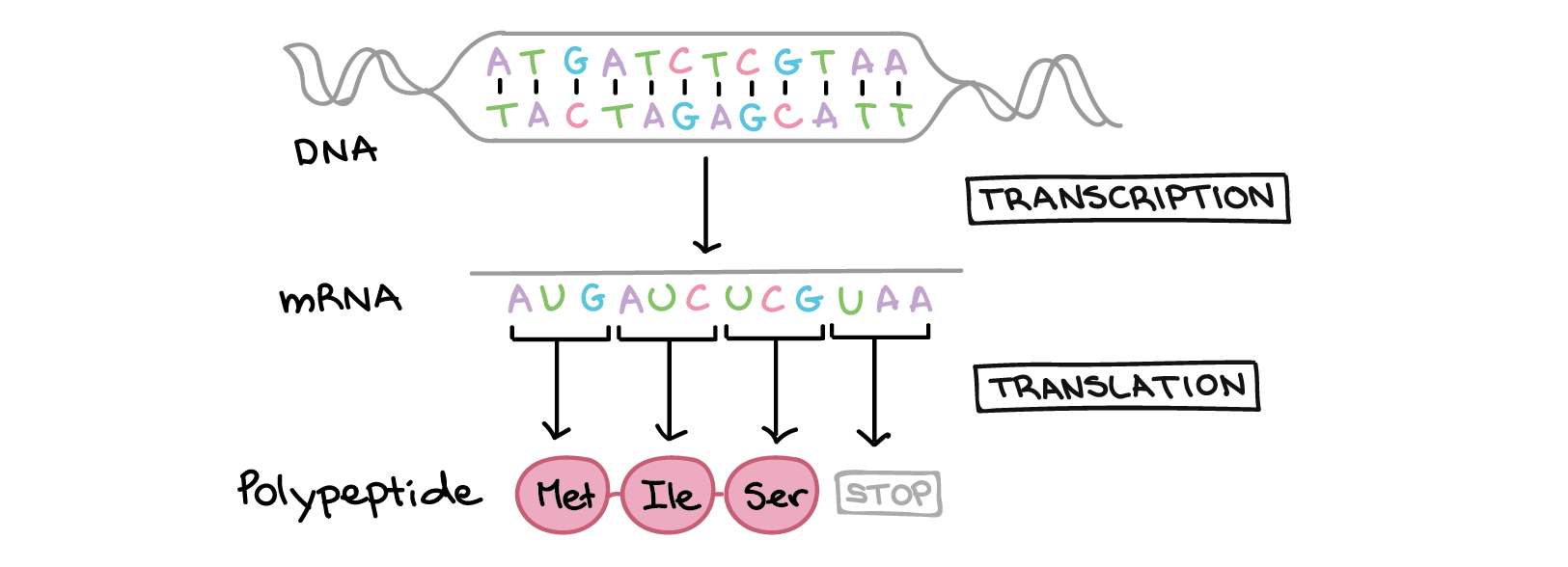

- #IN MESSENGER RNA EACH CODON SPECIFIES A PARTICULAR CODE#
- #IN MESSENGER RNA EACH CODON SPECIFIES A PARTICULAR SERIES#
Holley determined the structure of transfer RNA (tRNA), the adapter molecule that facilitates the process of translating RNA into protein. Subsequent work by Har Gobind Khorana identified the rest of the genetic code. Using various copolymers most of the remaining codons were then determined.

Therefore, the codon AAA specified the amino acid lysine, and the codon CCC specified the amino acid proline. This was followed by experiments in Severo Ochoa's laboratory that demonstrated that the poly- adenine RNA sequence (AAAAA.) coded for the polypeptide poly- lysine and that the poly- cytosine RNA sequence (CCCCC.) coded for the polypeptide poly- proline.

They thereby deduced that the codon UUU specified the amino acid phenylalanine. They used a cell-free system to translate a poly- uracil RNA sequence (i.e., UUUUU.) and discovered that the polypeptide that they had synthesized consisted of only the amino acid phenylalanine. Matthaei were the first to reveal the nature of a codon in 1961. The Crick, Brenner, Barnett and Watts-Tobin experiment first demonstrated that codons consist of three DNA bases. See also: DNA and RNA codon tables § Translation table 1 The adaptor was later identified as tRNA.
#IN MESSENGER RNA EACH CODON SPECIFIES A PARTICULAR CODE#
The hypothesis states that the triplet code was not passed on to amino acids as Gamow thought, but carried by a different molecule, an adaptor, that interacts with amino acids. Crick presented a type-written paper titled "On Degenerate Templates and the Adaptor Hypothesis: A Note for the RNA Tie Club" to the members of the club in January 1955, which "totally change the way we thought about protein synthesis", as Watson recalled. The first scientific contribution of the club, later recorded as "one of the most important unpublished articles in the history of science" and "the most famous unpublished paper in the annals of molecular biology", was made by Crick.

However, the club could have only 20 permanent members to represent each of the 20 amino acids and four additional honorary members to represent the four nucleotides of DNA. In 1954, Gamow created an informal scientific organisation the RNA Tie Club, as suggested by Watson, for scientists of different persuasions who were interested in how proteins were synthesised from genes. He named this DNA–protein interaction (the original genetic code) as the "diamond code". He postulated that sets of three bases (triplets) must be employed to encode the 20 standard amino acids used by living cells to build proteins, which would allow a maximum of 4 3 = 64 amino acids. Soviet-American physicist George Gamow was the first to give a workable scheme for protein synthesis from DNA. The key discoverers, English biophysicist Francis Crick and American biologist James Watson, working together at the Cavendish Laboratory of the University of Cambridge, hypothesied that information flows from DNA and that there is a link between DNA and proteins. That scheme is often referred to as the canonical or standard genetic code, or simply the genetic code, though variant codes (such as in mitochondria) exist.Įfforts to understand how proteins are encoded began after DNA's structure was discovered in 1953. The vast majority of genes are encoded with a single scheme (see the RNA codon table). With some exceptions, a three-nucleotide codon in a nucleic acid sequence specifies a single amino acid. The codons specify which amino acid will be added next during protein biosynthesis. The genetic code is highly similar among all organisms and can be expressed in a simple table with 64 entries. Translation is accomplished by the ribosome, which links proteinogenic amino acids in an order specified by messenger RNA (mRNA), using transfer RNA (tRNA) molecules to carry amino acids and to read the mRNA three nucleotides at a time. The genetic code is the set of rules used by living cells to translate information encoded within genetic material ( DNA or RNA sequences of nucleotide triplets, or codons) into proteins. This mRNA molecule will instruct a ribosome to synthesize a protein according to this code. The nucleotides are abbreviated with the letters A, U, G and C. Each codon consists of three nucleotides, usually corresponding to a single amino acid.
#IN MESSENGER RNA EACH CODON SPECIFIES A PARTICULAR SERIES#
Rules by which information encoded within genetic material is translated into proteinsĪ series of codons in part of a messenger RNA (mRNA) molecule.


 0 kommentar(er)
0 kommentar(er)
